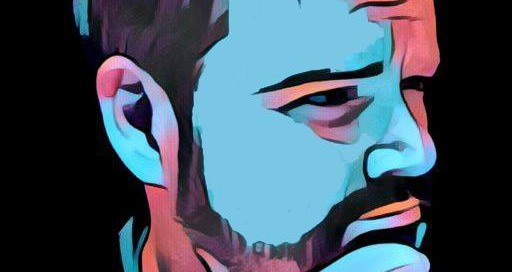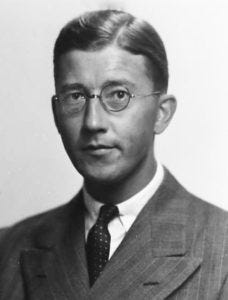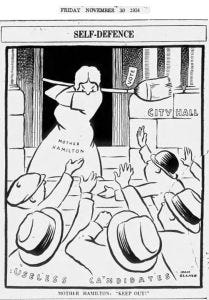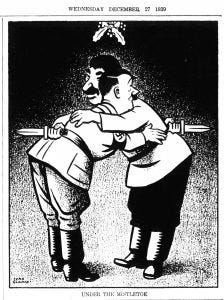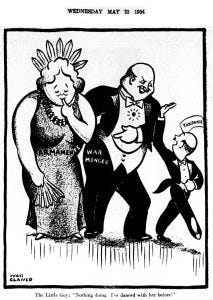Rediscovering Ivan Glassco: The Unearthed Legacy of a Canadian Cartoonist
Editorial cartoonists are society’s ‘canaries in the coal mine’ - The Hamilton Spectator, Saturday November 2, 2024
When I embarked on my deep dive into the work of Ivan Russell Glassco, the legendary editorial cartoonist for The Hamilton Spectator, I knew I was in for a journey rich with discovery. What I didn't anticipate was how this project would redefine not just my appreciation of Glassco's art but my understanding of historical journalism itself. This exploration was made possible by the recent, game-changing digitization of The Hamilton Spectator archives. No longer confined to the labourious task of threading scratchy microfilm through bulky readers, researchers like myself now have the luxury of scrolling through pages from nearly a century ago with the swipe of a finger, courtesy of newspapers.com.
Before this digitization effort, accessing anything prior to the early 2000s meant dusting off reels of microfilm, a process that was daunting at best. The flicker and hum of the machine, whether the repetitive hand-crank, or faulty electric spinners, and the inevitable eye strain were the hallmarks of archival research. But today, the stories and illustrations that once required hours to locate can be called up almost instantly, and for Glassco’s admirers, this is a treasure trove offers potential for research.
I've spent months meticulously scouring these digital archives, capturing screenshots of every Ivan Glassco editorial cartoon. Each one, often marred by the imperfections of its original medium—blotches, scratches, and the texture of aged newsprint—needed careful tending. Using a combination of image-editing tools, I cleaned up each scan, breathing new life into Glassco's bold, striking lines and ensuring his sharp wit and evocative symbolism stood as vividly as they once did on the printed page.
To make this collection functional for future studies, I've also added comprehensive metadata to each image: the date of publication, the context surrounding the cartoon, and thematic tags. This meticulous cataloging not only enriches my own research but opens up new possibilities for those who want to delve into Glassco’s era and impact without starting from scratch.
The 1930s were a decade of seismic change, punctuated by economic upheaval and the brewing shadows of global conflict. Glassco’s work chronicled this uneasy time with unmatched incisiveness. Each cartoon wasn’t just an illustration—it was a commentary that captured the heartbeat of a society grappling with uncertainty. His portrayal of political figures, economic woes, and public sentiment was laced with humour, empathy, and a clarity that resonated beyond the news cycle. These pieces, sometimes funny and at other times searingly somber, form a rich tableau of Canadian and world history as seen through Glassco’s eyes.
What isn’t always clear from the articles written about him is the versatility he brought to his work. His cartoons balanced the fine line between critique and entertainment; he managed to provoke thought without alienating his audience. There’s a palpable sincerity in his lines—whether sketching Roosevelt navigating the treacherous waters of the Great Depression or caricaturing local political disputes—that highlights a deep understanding of the human condition.
These digital restorations could form the basis of an exhibition, pairing each cartoon with the stories that surrounded them, or become part of an interactive online archive where educators and historians can draw connections between Glassco’s work and modern political cartoons. Perhaps a thematic compendium, highlighting how certain motifs evolved over his career, or even a classroom resource for illustrating the art of political commentary.
But for now, the work remains personal. It's an act of homage to an artist who, despite gaining acclaim in his day, didn’t live long enough to see the full extent of his influence. Each restored image is a reminder of Glassco’s ability to cut to the heart of an issue with only pen and paper. And each, too, underscores what was lost with his untimely death—a voice that, had history allowed, would have continued to shape public thought and dialogue through the fraught years of World War II and beyond.
My study of Ivan Glassco’s oeuvre, conducted one frame at a time, is a testament not just to his talent but to the importance of preserving and revisiting the voices of the past. His cartoons may have been born of the 1930s, but their resonance is timeless, calling out to be re-seen, re-understood, and celebrated anew. Read in the Hamilton Spectator: Editorial cartoonists are society’s ‘canaries in the coal mine’
